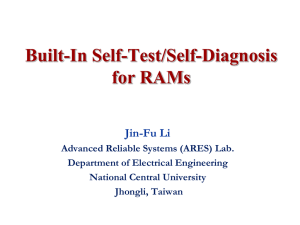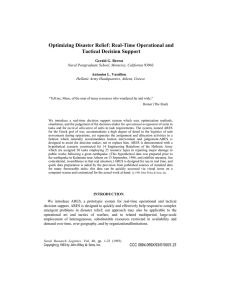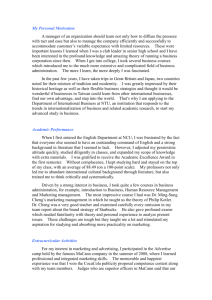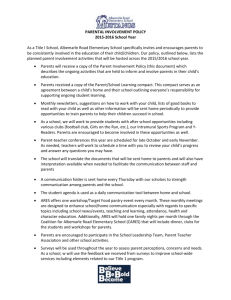Chapter 1 Chapter 1 Introduction
advertisement
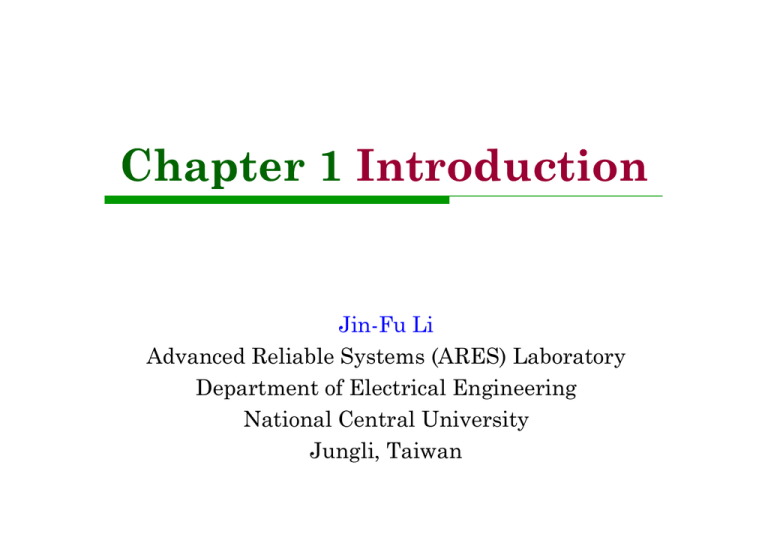
Chapter 1 Introduction Jin-Fu Li Advanced Reliable Systems (ARES) Laboratory Department of Electrical Engineering National Central University Jungli Taiwan Jungli, Outline VLSI Realization Role of Testing Defects, Faults, and Errors VLSI Testing Concepts Testing Economics Test Quality Measure Advanced Reliable Systems (ARES) Lab. Jin-Fu Li, EE, NCU 2 VLSI Realization Process Customer’s need Determine requirements Write specifications Design synthesis and Verification Test development Fabrication g test Manufacturing Chips to customer Advanced Reliable Systems (ARES) Lab. Jin-Fu Li, EE, NCU 3 Definitions Design synthesis Given an I/O function,, develop pap procedure to manufacture a device using known materials and processes Verification Predictive analysis to ensure that the synthesized design, when manufactured, will perform the given I/O function Test A manufacturing step that ensures that the physical device, manufactured from the synthesized design, has no manufacturing defect Advanced Reliable Systems (ARES) Lab. Jin-Fu Li, EE, NCU 4 Role of Testing If you design a product, fabricate, and test it, and it fails the test, then there must be a cause for the failure Test was wrong The fabrication p process was faulty y The design was incorrect p p problem The specification The role of testing is to detect whether something went wrong and the role of diagnosis is to determine exactly what went wrong Correctness and effectiveness of testing is most important for quality products Advanced Reliable Systems (ARES) Lab. Jin-Fu Li, EE, NCU 5 Benefits of Testing Quality and economy are two major benefits of testing Thee two attributes att butes are a e greatly g eat y dependent depe de t a and d ca can not ot be defined without the other Q Quality y means satisfying y g the user’s needs at a minimum cost The purpose of testing is to weed out all bad products before they reach the user The number of bad products heavily affect the price off good d products d A profound understanding of the principles of manufacturing f t i and d ttestt iis essential ti l ffor an engineer i to t design a quality product Advanced Reliable Systems (ARES) Lab. Jin-Fu Li, EE, NCU 6 Trends of Testing Two key factors are changing the way of VLSI ICs testing g The manufacturing test cost has been not scaling The effort to g generate tests has been g growing g geometrically along with product complexity Cost: cents/transistor 1 0.1 Si capital/transistor 0.01 0.001 0.0001 Test capital/transistor 0.00001 0.000001 0.0000001 Source: SIA 1982 1985 1988 1991 1994 1997 2000 2003 2006 2009 2012 Advanced Reliable Systems (ARES) Lab. Jin-Fu Li, EE, NCU 7 Test Knowledge is Important Testing is becoming a factor in design optimization Designers customarily strive for an optimal design A high-speed, low-power design occupying the smallest possible area Conventionally, the designer often optimize one of the tree attributes: speed p ((or delay), y), area,, and p power At present, a fourth attribute is considered Testabilityy Nowadays, the testability cycle should parallel the design cycle Advanced Reliable Systems (ARES) Lab. Jin-Fu Li, EE, NCU 8 As Technology Scales Continuously Die size, chip yield, and design productivity have so far limited transistor integration in a VLSI design gy Now the focus has shifted to energy consumption, power dissipation, and power delivery y As technology scales further we will face new challenges such as variability, challenges, variability single-event single event upsets (soft errors), and device (transistor performance) degradation degradation− these effects manifesting as inherent unreliability of the components posing design and test challenges components, Source: S. Borkar (Intel Corp.), IEEE Micro, 2005 Advanced Reliable Systems (ARES) Lab. Jin-Fu Li, EE, NCU 9 Possible Solution to Conquer Unreliability We could distribute test functionality as a part of the hardware to dynamically y y detect errors,, or to correct and isolate aging and faulty hardware. Or a subset of cores in the multicore design g could perform p f this work. This microarchitecture strategy, with multicores to assist in redundancy, y, is called resilient microarchitecture. It continuously detects errors, isolates faults, confines ffaults,, reconfigures fg the hardware,, and thus adapts. p Iff we can make such a strategy work, there is no need for ontime ffactoryy testing, g, burn in,, since the system y is capable p of testing and reconfiguring itself to make itself work reliablyy throughout g its lifetime. f Source: S. Borkar (Intel Corp.), IEEE Micro, 2005 Advanced Reliable Systems (ARES) Lab. Jin-Fu Li, EE, NCU 10 Itanium (JSSC, Jan. 2006) Advanced Reliable Systems (ARES) Lab. Jin-Fu Li, EE, NCU 11 Cell Processor (JSSC, Jan. 2006) Advanced Reliable Systems (ARES) Lab. Jin-Fu Li, EE, NCU 12 Defect, Fault, and Error Defect A defect is the unintended difference between the implemented hardware and its intended design Defects occur either during manufacture or during the use of devices Fault A representation of a defect at the abstracted function level Error A wrong g output p signal g p produced by y a defective system An error is caused by a fault or a design error Advanced Reliable Systems (ARES) Lab. Jin-Fu Li, EE, NCU 13 Typical Types of Defects Extra and missing material Primarily y caused by y dust p particles on the mask or wafer surface, or in the processing chemicals Oxide breakdown Primarily caused by insufficient oxygen at the interface of silicon (Si) and silicon dioxide (SiO2), chemical contamination, and crystal defects Electromigration g Primarily caused by the transport of metal atoms when a current flows through the wire Because of a low melting point, aluminum has large self-diffusion properties, which increase its electromigration l i i liability li bili Advanced Reliable Systems (ARES) Lab. Jin-Fu Li, EE, NCU 14 Example Consider one two-input AND gate a c b Defect: a short to ground a b Gnd a b c Fault: signal b stuck at logic 0 Error: a=1, b=1, c=0 (correct output c=1) Note that the error is not permanent permanent. As long as at least one input is 0, there is no error in the output Advanced Reliable Systems (ARES) Lab. Jin-Fu Li, EE, NCU 15 Defect, Fault, and Error Different types of defects may cause the same fault c a b c a b Different types of faults may cause the same error E.g., A stuck-at-0, Y=1; C stuck-at-1, Y=1 C D S/1 Advanced Reliable Systems (ARES) Lab. A B S/0 Jin-Fu Li, EE, NCU Y 16 The Test Problem Defect Fault Test pattern Fault coverage Fault modeling Test pattern Fault simulation generation C S/1 D Advanced Reliable Systems (ARES) Lab. Y C D Y Y(C is S/1) 0 0 1 1 0 1 0 1 0 1 1 1 1 1 1 1 Jin-Fu Li, EE, NCU 17 Ideal Tests & Real Tests The problems of ideal tests Ideal tests detect all defects produced in the manufacturing process Ideal tests pass all functionally good devices Very large numbers and varieties of possible defects need to be tested Difficult to generate tests for some real defects Real tests Based on analyzable fault models, which may not map on real defects Incomplete coverage of modeled faults due to high complexity Some good chips are rejected. The fraction (or percentage) of such chips p is called the y yield loss Some bad chips pass tests. The fraction (or percentage) of bad chips among all passing chips is called the defect level Advanced Reliable Systems (ARES) Lab. Jin-Fu Li, EE, NCU 18 How to Test Chips? Test patterns Test responses ---11 10--- ---01 00--- …… Circuit under test …… ---00 01--- ---10 10--- Stored Correct Comparator Responses Test result Advanced Reliable Systems (ARES) Lab. Jin-Fu Li, EE, NCU 19 Cost of Test Design for testability (DFT) Chip p area overhead and y yield reduction Performance overhead Software processes of test Test generation and fault simulation Test programming and debugging Manufacturing test Automatic A i test equipment i (ATE) capital it l costt Test center operational cost Advanced Reliable Systems (ARES) Lab. Jin-Fu Li, EE, NCU 20 ADVENTEST Model T6682 ATE Consists of Powerful computer Powerful 32-bit digital signal g p processor ((DSP)) for analog testing Probe head: actually touches the bare dies or packaged chips to perform f f lt detection fault d t ti experiments Probe card: contains electronics to measure pp pin or p pad chip Advanced Reliable Systems (ARES) Lab. Jin-Fu Li, EE, NCU 21 Internal Structure of the ATE Test Program Pattern P tt Memory Clocking Pin Pin Pin Pin Electronics Pin Electronics Pi Pin Electronics Pin Electronics Electronics Electronics Electronics Intern nal Bus Chip Under Test (CUT) Generators Analyzers STIL 1.0; System Controller Disk Workstation Source: H.-J. Huang, CIC Advanced Reliable Systems (ARES) Lab. Jin-Fu Li, EE, NCU 22 ATE Test Operation Pattern Memory Input Drivers Expected p Response STIL 1.0; Test Program Compare Output Pass/Fail Input Stimulus CUT Actual Response Local Per-Pin Memory Source: H.-J. Huang, CIC Advanced Reliable Systems (ARES) Lab. Jin-Fu Li, EE, NCU 23 Types of Test Characterization testing A.k.s. design debug or verification testing Performed on a new design before it is sent to production Verify whether the design is correct and the device will meet all specifications p AC and DC Functional tests and comprehensive measurements are made A characterization test determines the exact limits off device d i operation ti values l DC Parameter tests Measure steady-state steady state electrical characteristics For example, threshold test 0<VOL<VIL VIH<VOH<VCC Advanced Reliable Systems (ARES) Lab. Jin-Fu Li, EE, NCU 24 Types of Test AC parametric tests Measure transient electronic characteristics For example: Rise time & fall time tests Advanced Reliable Systems (ARES) Lab. Jin-Fu Li, EE, NCU 25 Types of Test Production testing Every fabricated chip is subjected to production t t tests The test patterns may not cover all possible functions and data patterns but must have a high fault coverage of modeled faults The main driver is cost, since every device must be tested. Test time must be absolutely minimized Only a go/no-go decision is made Test T t whether h th some device-under-test d i d t t parameters t are met to the device specifications under normal operating p g conditions Burn-In testing Ensure reliability of tested devices by testing Detect the devices with potential failures Advanced Reliable Systems (ARES) Lab. Jin-Fu Li, EE, NCU 26 Types of Test The potential failures can be accelerated at elevated temperatures The devices with infant mortality failures may be screened out by a short-term burn-in test in an accelerate l Failure rate versus product lifetime (bathtub curve) Failure rate Infant Working lifetime Wear out mortality Advanced Reliable Systems (ARES) Lab. Time Jin-Fu Li, EE, NCU 27 Testing Economics Chips must be tested before they are assembled onto PCBs, which, in turn, must be tested before they are assembled into systems The rule of ten If a chip fault is not detected by chip testing, then finding the fault costs 10 times as much at the PCB l level l as att the th chip hi level l l Similarly, if a board fault is not found by PCB testing then finding the fault costs 10 times as testing, much at the system level as at the board level Some claim that the rule of ten should be renamed the rule of twenty Chips, boards, and systems are more complex Advanced Reliable Systems (ARES) Lab. Jin-Fu Li, EE, NCU 28 VLSI Chip Yield A manufacturing defect is a finite chip area with electrically malfunctioning circuitry caused by errors in the fabrication process A chip with no manufacturing defect is called a good chip Fraction F ti ((or percentage) t ) off good d chips hi produced d d in a manufacturing process is called the yield. Yi ld iis d Yield denoted t d by b symbol b lY Cost of a chip Cost of fabricating and testing a wafer Yield x Number of chip p sites on the wafer Advanced Reliable Systems (ARES) Lab. Jin-Fu Li, EE, NCU 29 VLSI Chip Yield Good chips Faulty chips Defects W f Wafer Wafer yield = 12/22 = 0.55 Advanced Reliable Systems (ARES) Lab. Wafer yield = 17/22 = 0.77 Jin-Fu Li, EE, NCU 30 Fault Coverage & Defect Level Fault coverage (FC) The measure of the ability y of a test ((a collection of test patterns) to detect a given faults that may occur on the device under test FC=#(detected FC #(d t t d faults)/#(possible f lt )/#( ibl ffaults) lt ) Defect level (DL) Th The ratio ti off faulty f lt chips hi among the th chips hi that th t pass tests DL is measured as defects per million (DPM) DL is a measure of the effectiveness of tests DL is a quantitative measure of the manufactured product quality. For commercial VLSI chips a DL greater than 500 DPM is considered unacceptable ( 1 − FC ) DL = 1 − Y and d 0 < DL ≤ 1 − Y Advanced Reliable Systems (ARES) Lab. Jin-Fu Li, EE, NCU 31 Defect Level & Quality Level For example, required FC for DL=200 DPM Y(%) 10 50 FC(%) 99.991 99.97 90 99.8 95 99.6 99 98 Quality level (QL) The fraction of good parts among the parts that pass all the tests and are shipped QL = 1 − DL = Y (1 − FC ) and 0 ≤ QL ≤ 1 Consequently, fault coverage affects the quality level Advanced Reliable Systems (ARES) Lab. Jin-Fu Li, EE, NCU 32 Summary Efficient test strategies can heavily reduce the cost of a chip Fault modeling makes the test be analyzable and reduces the complexity of testing The quality of tests affect the quality of products d t Advanced Reliable Systems (ARES) Lab. Jin-Fu Li, EE, NCU 33

